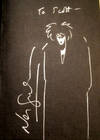
Conservation of Isotopic Spin and Isotopic Gauge Invariance in Physical Review 96, 1, October 1, 1954, pp. 191-196
by Yang, C. N. and Mills, R. L
- Used
- Paperback
- first
- Condition
- See description
- Seller
-
West Branch, Iowa, United States
Payment Methods Accepted
About This Item
Lancaster: American Physical Society, 1954. 1st Edition. RARE FIRST EDITION, FIRST ISSUE IN ORIGINAL WRAPS of the Yang and Mills quantum mechanical theory, introduced in this paper and underappreciated at that time. The Yang-Mills theory is now the foundation of most of elementary particle theory; it is the mathematical foundation underlying "three of the four fundamental forces of nature that physicists succeeded in unifying in the last half of the 20th century: electromagnetism, the 'weak force' responsible for radioactive decay, and the 'strong force' responsible for holding the nuclei of atoms together" (Gale, World of Mathematics Summary). Yang and Mills proposed a tensor equation that relies on a quantum mechanical property called the 'mass gap.' "The laws of quantum physics stand to the world of elementary particles in the way that Newton's laws of classical mechanics stand to the macroscopic world.
Almost half a century ago, Yang and Mills introduced a remarkable new framework to describe elementary particles using structures that also occur in geometry. The successful use of Yang-Mills theory (now widely tested and affirmed) to describe the strong interactions of elementary particles depends on a subtle quantum mechanical property called the "mass gap:" the quantum particles have positive masses, even though the classical waves travel at the speed of light. This property has been discovered by physicists from experiment and confirmed by computer simulations, but it still has not been understood from a theoretical point of view. Progress in establishing the existence of the Yang-Mills theory and a mass gap and will require the introduction of fundamental new ideas both in physics and in mathematics" (Clay Mathematics Institute). CONDITION & DETAILS: Lancaster: American Physical Society. Volume 96, Number 1, October 1, 1954. Pp. 191-196. (10.5 x 8 inches). Complete issue with flat creasing to the front wrap impacting none of the interior. See photo. The wraps are bright and clean; owner's signature on front wrap; small mark next to a paper noted on the list of contents on the rear wrap. Bright and exceptionally clean within.
Almost half a century ago, Yang and Mills introduced a remarkable new framework to describe elementary particles using structures that also occur in geometry. The successful use of Yang-Mills theory (now widely tested and affirmed) to describe the strong interactions of elementary particles depends on a subtle quantum mechanical property called the "mass gap:" the quantum particles have positive masses, even though the classical waves travel at the speed of light. This property has been discovered by physicists from experiment and confirmed by computer simulations, but it still has not been understood from a theoretical point of view. Progress in establishing the existence of the Yang-Mills theory and a mass gap and will require the introduction of fundamental new ideas both in physics and in mathematics" (Clay Mathematics Institute). CONDITION & DETAILS: Lancaster: American Physical Society. Volume 96, Number 1, October 1, 1954. Pp. 191-196. (10.5 x 8 inches). Complete issue with flat creasing to the front wrap impacting none of the interior. See photo. The wraps are bright and clean; owner's signature on front wrap; small mark next to a paper noted on the list of contents on the rear wrap. Bright and exceptionally clean within.
Reviews
(Log in or Create an Account first!)
Details
- Bookseller
- Atticus Rare Books
(US)
- Bookseller's Inventory #
- 1562
- Title
- Conservation of Isotopic Spin and Isotopic Gauge Invariance in Physical Review 96, 1, October 1, 1954, pp. 191-196
- Author
- Yang, C. N. and Mills, R. L
- Book Condition
- Used
- Quantity Available
- 1
- Edition
- 1st Edition
- Binding
- Paperback
- Publisher
- American Physical Society
- Place of Publication
- Lancaster
- Date Published
- 1954
- Keywords
- Quantum Theory Particle Theory
Terms of Sale
Atticus Rare Books
30 day return guarantee, with full refund including shipping costs for up to 30 days after delivery if an item arrives misdescribed or damaged.
About the Seller
Atticus Rare Books
Biblio member since 2010
West Branch, Iowa
About Atticus Rare Books
We specialize in rare and unusual antiquarian books in the sciences and the history of science. Additionally, we specialize in 20th century physics, mathematics, and astronomy.
Glossary
Some terminology that may be used in this description includes:
- First Edition
- In book collecting, the first edition is the earliest published form of a book. A book may have more than one first edition in...
- New
- A new book is a book previously not circulated to a buyer. Although a new book is typically free of any faults or defects, "new"...

